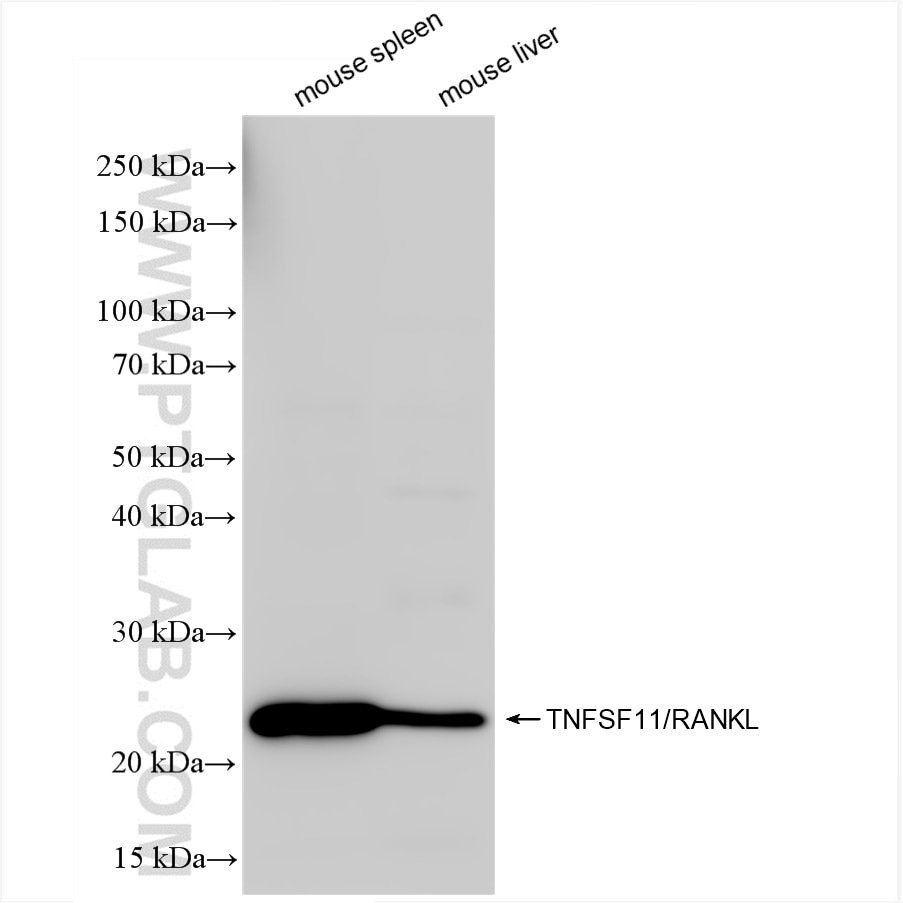Product Information
84431-5-PBS targets TNFSF11/RANKL in WB, IHC, Indirect ELISA applications and shows reactivity with mouse samples.
| Tested Reactivity | mouse |
| Host / Isotype | Rabbit / IgG |
| Class | Recombinant |
| Type | Antibody |
| Immunogen |
CatNo: Eg1956 Product name: Recombinant Mouse TNFSF11/RANKL protein (rFc Tag)(HPLC verified) Source: mammalian cells-derived, pHZ-KIsec-N-rFc Tag: N-rFc Domain: 72-316 aa of NM_011613.3 Sequence: RAQMDPNRISEDSTHCFYRILRLHENADLQDSTLESEDTLPDSCRRMKQAFQGAVQKELQHIVGPQRFSGAPAMMEGSWLDVAQRGKPEAQPFAHLTINAASIPSGSHKVTLSSWYHDRGWAKISNMTLSNGKLRVNQDGFYYLYANICFRHHETSGSVPTDYLQLMVYVVKTSIKIPSSHNLMKGGSTKNWSGNSEFHFYSINVGGFFKLRAGEEISIQVSNPSLLDPDQDATYFGAFKVQDID Predict reactive species |
| Full Name | tumor necrosis factor (ligand) superfamily, member 11 |
| Calculated Molecular Weight | 35KD |
| Observed Molecular Weight | 22 kDa |
| GenBank Accession Number | NM_011613.3 |
| Gene Symbol | Tnfsf11 |
| Gene ID (NCBI) | 21943 |
| Conjugate | Unconjugated |
| Form | Liquid |
| Purification Method | Protein A purfication |
| UNIPROT ID | O35235 |
| Storage Buffer | PBS only, pH 7.3. |
| Storage Conditions | Store at -80°C. |
Background Information
TNFSF11, known as Tumor Necrosis Factor Superfamily Member 11, also known as RANKL (Receptor Activator of Nuclear Factor-κB Ligand), TRANCE, etc., is a member of the Tumor Necrosis Factor (TNF) superfamily.RANKL is a type II homotrimeric transmembrane protein located primarily at the plasma membrane. RANKL is a type II homotrimeric transmembrane protein located mainly at the plasma membrane, and in addition to the membrane-bound form (mRNAKL), it can also be cleaved by proteolytic cleavage of the cell membrane to produce the soluble form (sRANKL). The membrane-bound form of RANKL is the main form involved in triggering the RANKL/RANK signaling pathway and mediating osteoclastogenesis. Current studies have shown that TNFSF11 acts primarily in the immune and skeletal systems and has been implicated in the pathogenesis of degenerative bone diseases, carcinogenesis, and asthma.








